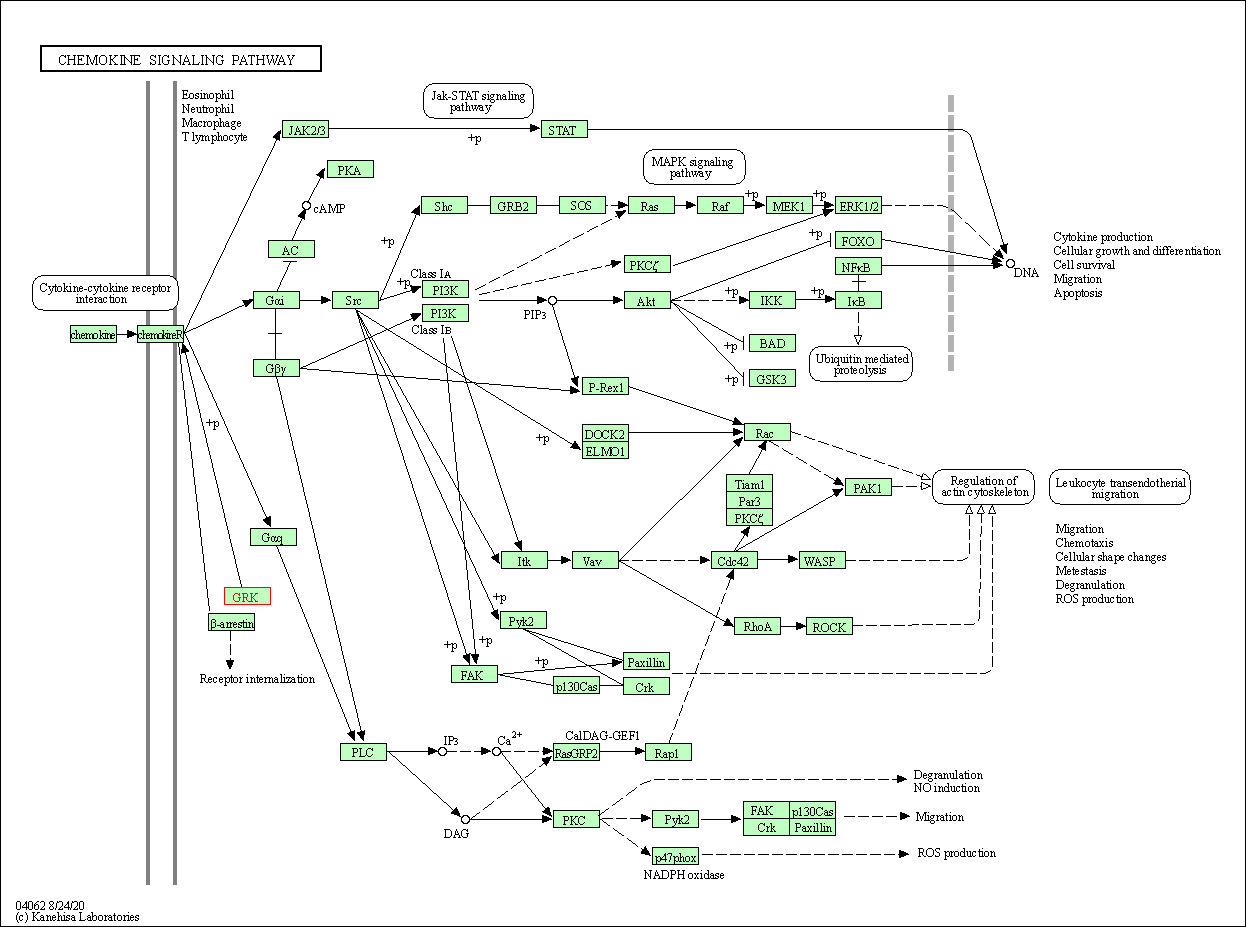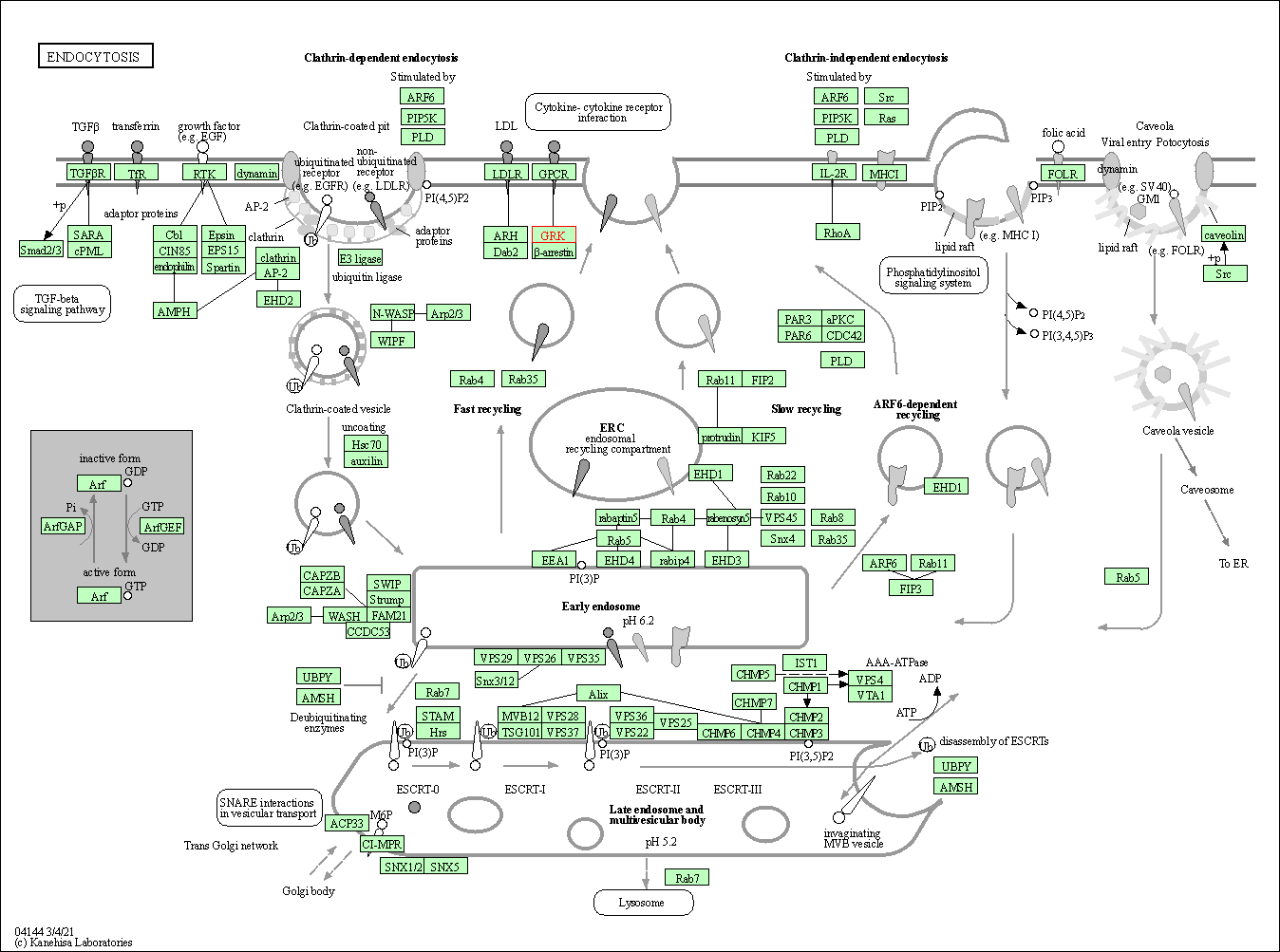Target Information
| Target General Information | Top | |||||
|---|---|---|---|---|---|---|
| Target ID |
T69612
(Former ID: TTDI03205)
|
|||||
| Target Name |
G protein-coupled receptor kinase 5 (GRK5)
|
|||||
| Synonyms |
GPRK5; G protein-coupled receptor kinase GRK5
Click to Show/Hide
|
|||||
| Gene Name |
GRK5
|
|||||
| Target Type |
Patented-recorded target
|
[1] | ||||
| Function |
Serine/threonine kinase that phosphorylates preferentially the activated forms of a variety of G-protein-coupled receptors (GPCRs). Such receptor phosphorylation initiates beta-arrestin-mediated receptor desensitization, internalization, and signaling events leading to their down-regulation. Phosphorylates a variety of GPCRs, including adrenergic receptors, muscarinic acetylcholine receptors (more specifically Gi-coupled M2/M4 subtypes), dopamine receptors and opioid receptors. In addition to GPCRs, also phosphorylates various substrates: Hsc70-interacting protein/ST13, TP53/p53, HDAC5, and arrestin-1/ARRB1. Phosphorylation of ARRB1 by GRK5 inhibits G-protein independent MAPK1/MAPK3 signaling downstream of 5HT4-receptors. Phosphorylation of HDAC5, a repressor of myocyte enhancer factor 2 (MEF2) leading to nuclear export of HDAC5 and allowing MEF2-mediated transcription. Phosphorylation of TP53/p53, a crucial tumor suppressor, inhibits TP53/p53-mediated apoptosis. Phosphorylation of ST13 regulates internalization of the chemokine receptor. Phosphorylates rhodopsin (RHO) (in vitro) and a non G-protein-coupled receptor, LRP6 during Wnt signaling (in vitro).
Click to Show/Hide
|
|||||
| UniProt ID | ||||||
| EC Number |
EC 2.7.11.16
|
|||||
| Sequence |
MELENIVANTVLLKAREGGGGKRKGKSKKWKEILKFPHISQCEDLRRTIDRDYCSLCDKQ
PIGRLLFRQFCETRPGLECYIQFLDSVAEYEVTPDEKLGEKGKEIMTKYLTPKSPVFIAQ VGQDLVSQTEEKLLQKPCKELFSACAQSVHEYLRGEPFHEYLDSMFFDRFLQWKWLERQP VTKNTFRQYRVLGKGGFGEVCACQVRATGKMYACKRLEKKRIKKRKGESMALNEKQILEK VNSQFVVNLAYAYETKDALCLVLTIMNGGDLKFHIYNMGNPGFEEERALFYAAEILCGLE DLHRENTVYRDLKPENILLDDYGHIRISDLGLAVKIPEGDLIRGRVGTVGYMAPEVLNNQ RYGLSPDYWGLGCLIYEMIEGQSPFRGRKEKVKREEVDRRVLETEEVYSHKFSEEAKSIC KMLLTKDAKQRLGCQEEGAAEVKRHPFFRNMNFKRLEAGMLDPPFVPDPRAVYCKDVLDI EQFSTVKGVNLDHTDDDFYSKFSTGSVSIPWQNEMIETECFKELNVFGPNGTLPPDLNRN HPPEPPKKGLLQRLFKRQHQNNSKSSPSSKTSFNHHINSNHVSSNSTGSS Click to Show/Hide
|
|||||
| 3D Structure | Click to Show 3D Structure of This Target | PDB | ||||
| HIT2.0 ID | T45RI0 | |||||
| Cell-based Target Expression Variations | Top | |||||
|---|---|---|---|---|---|---|
| Cell-based Target Expression Variations | ||||||
| Drug Binding Sites of Target | Top | |||||
|---|---|---|---|---|---|---|
| Ligand Name: AMP-PNP | Ligand Info | |||||
| Structure Description | Crystal Structure of G Protein-Coupled Receptor Kinase 5 in Complex with AMP-PNP | PDB:4TND | ||||
| Method | X-ray diffraction | Resolution | 1.80 Å | Mutation | No | [3] |
| PDB Sequence |
AREGGGGKRK
24 GKSKKWKEIL34 KFPHISQCED44 LRRTIDRDYC54 SLCDKQPIGR64 LLFRQFCETR 74 PGLECYIQFL84 DSVAEYEVTP94 DEKLGEKGKK104 IMTKYLTPKS114 PVFIAQVGQD 124 LVSQTEEKLL134 QKPCKELFSA144 CAQSVHEYLR154 GEPFHEYLDS164 MFFDRFLQWK 174 WLERQPVTKN184 TFRQYRVLGK194 GGFGEVCACQ204 VRATGKMYAC214 KRLEKKRIKK 224 RKGESMALNE234 KQILEKVNSQ244 FVVNLAYAYE254 TKDALCLVLT264 IMNGGDLKFH 274 IYNMGNPGFE284 EERALFYAAE294 ILCGLEDLHH304 ENTVYRDLKP314 ENILLDDYGH 324 IRISDLGLAV334 KIPEGDLIRG344 RVGTVGYMAP354 EVLNNQRYGL364 SPDYWGLGCL 374 IYEMIEGQSP384 FRGRKEKVKR394 EEVDRRVLET404 EEVYSHKFSE414 EAKSICKMLL 424 TKDAKQRLGC434 QEEEAAEVKR444 HPFFRNMNFK454 RLEAGMLDPP464 FVPDPRAVYC 474 KDVLDIEQFS484 TVKGVNLDHT494 DDDFYSKFST504 GSVSIPWQNE514 MIETECFKEL 524 NVFGPNGTLP534 PDLNRNHPP
|
|||||
|
|
LEU192
3.936
GLY193
3.765
LYS194
3.771
GLY195
3.417
GLY196
3.423
VAL200
3.450
ALA213
3.422
LYS215
3.697
VAL247
4.447
LEU263
4.153
THR264
2.807
|
|||||
| Ligand Name: Sangivamycin | Ligand Info | |||||
| Structure Description | Crystal Structure of G Protein-Coupled Receptor Kinase 5 (GRK5) in Complex with Calmodulin (CaM) | PDB:6PJX | ||||
| Method | X-ray diffraction | Resolution | 1.96 Å | Mutation | Yes | [4] |
| PDB Sequence |
MELENIVANT
10 VLLKAREGGG20 GKRKGKSKKW30 KEILKFPHIS40 QCEDLRRTID50 RDYCSLCDKQ 60 PIGRLLFRQF70 CETRPGLECY80 IQFLDSVAEY90 EVTPDEKLGE100 KGKKIMTKYL 110 TPKSPVFIAQ120 VGQDLVSQTE130 EKLLQKPCKE140 LFSACAQSVH150 EYLRGEPFHE 160 YLDSMFFDRF170 LQWKWLERQP180 VTKNTFRQYR190 VLGKGGFGEV200 CACQVRATGK 210 MYACKRLEKK220 RIKKRKGESM230 ALNEKQILEK240 VNSQFVVNLA250 YAYETKDALC 260 LVLTIMNGGD270 LKFHIYNMGN280 PGFEEERALF290 YAAEILCGLE300 DLHHENTVYR 310 DLKPENILLD320 DYGHIRISDL330 GLAVKIPEGD340 LIRGRVGTVG350 YMAPEVLNNQ 360 RYGLSPDYWG370 LGCLIYEMIE380 GQSPFRGRKE390 KVKREEVDRR400 VLETEEVYSH 410 KFSEEAKSIC420 KMLLTKDAKQ430 RLGCQEEEAA440 EVKRHPFFRN450 MNFKRLEAGM 460 LDPPFVPDPR470 AVYCKDVLDI480 EQFSTVKGVN490 LDHTDDDFYS500 KFSTGSVSIP 510 WQNEMIETEC520 FKELNVFGPN530 GTLPPDLNRN540 HP
|
|||||
|
|
||||||
| Click to View More Binding Site Information of This Target and Ligand Pair | ||||||
| Click to View More Binding Site Information of This Target with Different Ligands | ||||||
| Different Human System Profiles of Target | Top |
|---|---|
|
Human Similarity Proteins
of target is determined by comparing the sequence similarity of all human proteins with the target based on BLAST. The similarity proteins for a target are defined as the proteins with E-value < 0.005 and outside the protein families of the target.
A target that has fewer human similarity proteins outside its family is commonly regarded to possess a greater capacity to avoid undesired interactions and thus increase the possibility of finding successful drugs
(Brief Bioinform, 21: 649-662, 2020).
Human Tissue Distribution
of target is determined from a proteomics study that quantified more than 12,000 genes across 32 normal human tissues. Tissue Specificity (TS) score was used to define the enrichment of target across tissues.
The distribution of targets among different tissues or organs need to be taken into consideration when assessing the target druggability, as it is generally accepted that the wider the target distribution, the greater the concern over potential adverse effects
(Nat Rev Drug Discov, 20: 64-81, 2021).
Human Pathway Affiliation
of target is determined by the life-essential pathways provided on KEGG database. The target-affiliated pathways were defined based on the following two criteria (a) the pathways of the studied target should be life-essential for both healthy individuals and patients, and (b) the studied target should occupy an upstream position in the pathways and therefore had the ability to regulate biological function.
Targets involved in a fewer pathways have greater likelihood to be successfully developed, while those associated with more human pathways increase the chance of undesirable interferences with other human processes
(Pharmacol Rev, 58: 259-279, 2006).
Biological Network Descriptors
of target is determined based on a human protein-protein interactions (PPI) network consisting of 9,309 proteins and 52,713 PPIs, which were with a high confidence score of ≥ 0.95 collected from STRING database.
The network properties of targets based on protein-protein interactions (PPIs) have been widely adopted for the assessment of target’s druggability. Proteins with high node degree tend to have a high impact on network function through multiple interactions, while proteins with high betweenness centrality are regarded to be central for communication in interaction networks and regulate the flow of signaling information
(Front Pharmacol, 9, 1245, 2018;
Curr Opin Struct Biol. 44:134-142, 2017).
Human Similarity Proteins
Human Tissue Distribution
Human Pathway Affiliation
Biological Network Descriptors
|
|
|
Note:
If a protein has TS (tissue specficity) scores at least in one tissue >= 2.5, this protein is called tissue-enriched (including tissue-enriched-but-not-specific and tissue-specific). In the plots, the vertical lines are at thresholds 2.5 and 4.
|
| KEGG Pathway | Pathway ID | Affiliated Target | Pathway Map |
|---|---|---|---|
| Chemokine signaling pathway | hsa04062 | Affiliated Target |

|
| Class: Organismal Systems => Immune system | Pathway Hierarchy | ||
| Endocytosis | hsa04144 | Affiliated Target |

|
| Class: Cellular Processes => Transport and catabolism | Pathway Hierarchy | ||
| Degree | 2 | Degree centrality | 2.15E-04 | Betweenness centrality | 1.04E-05 |
|---|---|---|---|---|---|
| Closeness centrality | 2.11E-01 | Radiality | 1.37E+01 | Clustering coefficient | 0.00E+00 |
| Neighborhood connectivity | 3.30E+01 | Topological coefficient | 5.00E-01 | Eccentricity | 12 |
| Download | Click to Download the Full PPI Network of This Target | ||||
| Chemical Structure based Activity Landscape of Target | Top |
|---|---|
| Drug Property Profile of Target | Top | |
|---|---|---|
| (1) Molecular Weight (mw) based Drug Clustering | (2) Octanol/Water Partition Coefficient (xlogp) based Drug Clustering | |
|
|
||
| (3) Hydrogen Bond Donor Count (hbonddonor) based Drug Clustering | (4) Hydrogen Bond Acceptor Count (hbondacc) based Drug Clustering | |
|
|
||
| (5) Rotatable Bond Count (rotbonds) based Drug Clustering | (6) Topological Polar Surface Area (polararea) based Drug Clustering | |
|
|
||
| "RO5" indicates the cutoff set by lipinski's rule of five; "D123AB" colored in GREEN denotes the no violation of any cutoff in lipinski's rule of five; "D123AB" colored in PURPLE refers to the violation of only one cutoff in lipinski's rule of five; "D123AB" colored in BLACK represents the violation of more than one cutoffs in lipinski's rule of five | ||
| Target Poor or Non Binders | Top | |||||
|---|---|---|---|---|---|---|
| Target Poor or Non Binders | ||||||
| References | Top | |||||
|---|---|---|---|---|---|---|
| REF 1 | Design and synthesis of novel 3-(benzo[d]oxazol-2-yl)-5-(1-(piperidin-4-yl)-1H-pyrazol-4-yl)pyridin-2-amine derivatives as selective G-protein-coupled receptor kinase-2 and -5 inhibitors. Bioorg Med Chem Lett. 2013 Dec 15;23(24):6711-6. | |||||
| REF 2 | G protein-coupled receptor kinase 2 inhibitors and methods for use of the same. US10023564. | |||||
| REF 3 | Atomic Structure of GRK5 Reveals Distinct Structural Features Novel for G Protein-coupled Receptor Kinases. J Biol Chem. 2015 Aug 21;290(34):20629-20647. | |||||
| REF 4 | Structure of a GRK5-Calmodulin Complex Reveals Molecular Mechanism of GRK Activation and Substrate Targeting. Mol Cell. 2021 Jan 21;81(2):323-339.e11. | |||||
If You Find Any Error in Data or Bug in Web Service, Please Kindly Report It to Dr. Zhou and Dr. Zhang.

